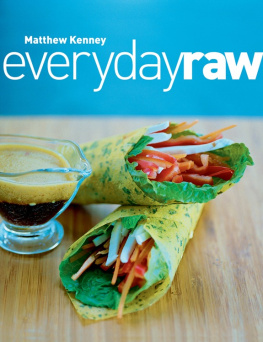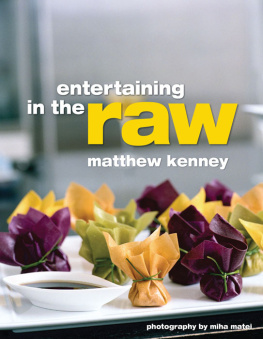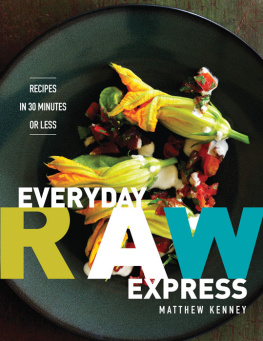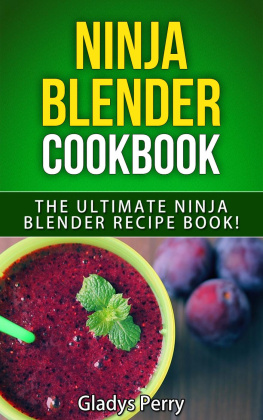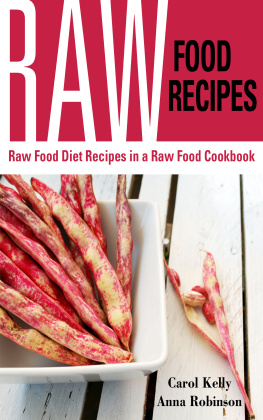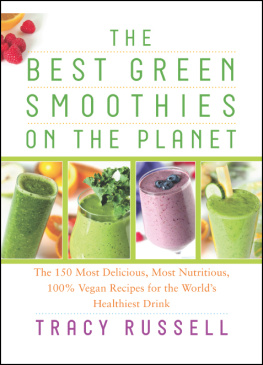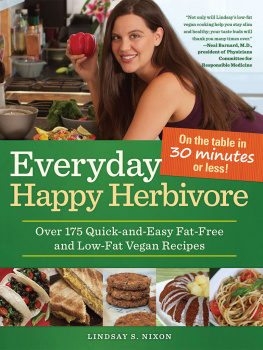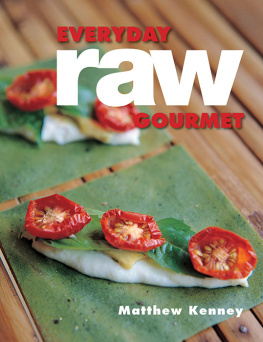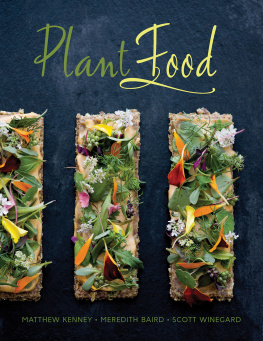All rights reserved. No part of this book may be reproduced by any means whatsoever without written permission from the publisher, except brief portions quoted for purpose of review.
Everyday Raw / Matthew Kenney : photographs by Miha Matei. - 1st ed.
1. Vegetarian cookery. 2. Raw foods. I. Title
Introduction
Raw food is a miracleit is so simple and obvious that we have made it complicated in order to find its core again. It is full of flavor, vibrant, and colorful, and great for our health. It is also challenging to prepare properly, because everything must be made from whole, fresh, and preferably organic ingredients, none of which may be heated above 118 degrees. As a result, the growing popularity of the lifestyle has bred many complex recipes and techniques, all with the goal of creating gourmet raw food. It is in our nature to experiment and, given the limitations involved when staying raw, the bar has been set high. In fact, I am one of the guilty ones, not only having opened several upscale raw cafes and restaurants in Manhattan, but also planning new ones in Miami and even India. But, those will be restaurants, with restaurant food, and a large staff whose sole mission is to prepare amazing meals. At home, I am like everyone else, working alone in the kitchen with a very limited amount of time on my hands. I love to prepare complex meals for dinner parties and friends when I can, but that is not often these days. In my day-to-day life, I have a far smaller window in which to put together recipes. Still, being a chef, I cant suppress my desire to have great tasting foods on a daily basis. When I began eating raw food a few years ago, I also had to relearn all of my domestic culinary secrets, as I had done in my previous pre-vegan life. Those secrets are what allow me to eat well and creatively at home, but with far less work. The type of raw food that is best at home is unfussy and is made up of very satisfying ingredients, with far fewer components and fewer steps; and its easier to prepare in a shorter amount of time. Everyday raw food does not necessarily translate to simplefor better or worse, raw food will never be as easy as opening a can or popping something in the microwave. That comes with the territory when you are committed to a life of fresh fruits and vegetables. It is simply a good amount of work (or pleasure, depending on how you qualify it). But there are ways to streamline the challenge, and that is what this book is aboutpreparing restaurant-quality flavors in less time.
The recipes in this book also recognize the lifestyle factor involved in raw food. At a restaurant, the menu may be about elaborate creations, but at home, it is often preferable to have a smoothie or snack rather than a meal. For that reason, I have added a large number of my favorite smoothies and juicesmany that have enough nutrition and energy in them to carry you all afternoon. There are also several component recipes that I like to call building blocks, or supporting characters. Added to any dish, they can quickly elevate it from something ordinary to something special.
You should always look at these recipes as a road map onlythey can be adjusted, substitutions can be made, or components can be added to something else. The goal is to provide you with enough information and ideas to help with your day-to-day raw life. Keep it simple, fresh, organic, real, and delicious.
My Philosophy
Although my food preferences have changed dramatically over the years, my culinary influences have not. Many years ago, the staff at my first restaurant used to make fun of how often I would use the words clean and sexy to describe how I wanted our food to be presented. I havent wavered in my preferences on that level: I like food that is somewhat light, or lighter than usual, and very intensely flavored, yet not muddled with too many components. If an ingredient does not have a real purpose in a recipe, I prefer to leave it out.
The far most important element of raw food, or any food for that matter, is the sourcing of high quality, seasonal, local when possible, organic ingredients. Without them, you are already limiting your chances of prearing great healthy food.
Having traveled extensively in the Mediterranean, I am strongly influenced by its cuisine, which is very seasonal, vibrant, and based on many ingredients that I still love today: olive oil, tomatoes, green vegetables, fresh fruits, spices, and nuts. Little did I know what a large role those part-time components would eventually play in my culinary pursuits.
Raw food is, by its own nature, very unique and without the tradition of other cuisines. In order to keep it somewhat grounded, I firmly believe in respecting cultural influencesfor example, if we are preparing an Indian-inspired recipe, I work hard to keep the flavors as they would be in that cuisine, rather than also introduce a Thai ingredient. Although my first cookbook made liberal use of garlic, onions, and shallots, I have since gotten away from using too much of any of those. As I transitioned into raw foods, I also began paying more attention to how they made me feel and how they are digested. This is a personal philosophy; and even though we do use some of these ingredients, they are not automatically added to a dish and are only used when I feel that they add immeasurably to the recipe.
The far most important element of raw food, or any food for that matter, is the sourcing of high quality, seasonal, local when possible, organic ingredients. Without them, you are already limiting your chances of preparing great, healthy food. I was fortunate to grow up on the coast of Maine, with a garden in the backyard and an ocean in the front. It taught me a lot about seasonality, and the respect I have for seasonal ingredients is stronger than ever. I prefer to purchase ingredients that have not been on an airplane if possible. In the best world, I would like to eat food that never made its way into a refrigerator. But that will be another dayfor now, I simply would like to emphasize that the quality of ingredients is critical. With raw food, we do rely on many ingredients that come from afar, like young Thai coconuts. At the moment, they are invaluable. In the future, I do envision a raw cuisine that makes less use of some of these ingredients, but for now, enjoy them!
A frequent comment from people who are interested in preparing raw food is that it requires a lot of special equipment. That is not really the case. If I were living in a climate that was raw food friendly and ever decided to build a new home from the ground up, it would not have a traditional oven and stove, but rather a big stone and marble counter, with one small dehydrator, a couple of blenders, good sharp knives, an oak cutting board, a mandoline (slicer), and a food processor. Compare that to a gas or electric range, an exhaust fan, and numerous other gadgets. It is quite simplebut different. A dehydrator costs just over $200. Buy one instead of a microwave and preserve your foods nutrients rather than destroy them. All in all, the raw kitchen is very easy to put together and maintain.

